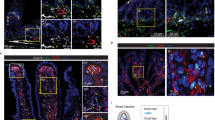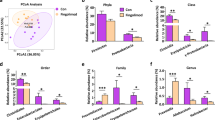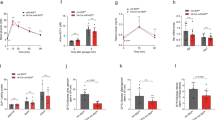Abstract
Mutations in ATP8B1 are associated with FIC1 disease, an autosomal recessive disorder in which intrahepatic cholestasis is the predominant manifestation. ATP8B1 encodes FIC1, which is expressed in several tissues, most prominently in the intestine, pancreas, and stomach and, to a much lesser extent, in the liver. In this study, Fic1 localization and expression during postnatal development was examined in healthy mice. Immunoblot and RT-PCR analysis indicated Fic1 is expressed abundantly in regions of the adult gastrointestinal tract of humans and mice. Immunohistochemistry revealed that Fic1 was localized to the apical membranes of enterocytes, pancreatic acinar cells, gastric pit epithelial cells, and hepatocytes and cholangiocytes. Subsequent analysis of early postnatal expression revealed that Fic1 expression in the small intestine was limited or absent at the age of 7 and 14 d and increased significantly with maturation. In contrast, pancreatic, hepatic, and gastric Fic1 expression was not diminished during the first 3 wk of postnatal development. In conclusion, these data show that Fic1 is expressed in a tissue-specific and developmentally regulated fashion at the apical membranes of epithelial cells. We speculate that the developing bile salt pool in the maturing intestine accounts for the increase in Fic1 protein expression in this tissue.
Similar content being viewed by others
Log in or create a free account to read this content
Gain free access to this article, as well as selected content from this journal and more on nature.com
or
Abbreviations
- ASBT:
-
apical sodium-dependent bile salt transporter
- BRIC:
-
benign recurrent intrahepatic cholestasis
- FIC1:
-
familial intrahepatic cholestasis 1
- GFC:
-
Greenland familial cholestasis
- GGT:
-
γ-glutamyltranspeptidase
- IBABP:
-
ileal bile acid binding protein
- PFIC1:
-
progressive familial intrahepatic cholestasis type 1
- SCHAD:
-
short chain L-3-hydroxyacyl-CoA
References
Muller M, Jansen PL 1998 The secretory function of the liver: new aspects of hepatobiliary transport. J Hepatol 28: 344–354
Trauner M, Meier PJ, Boyer JL 1998 Molecular pathogenesis of cholestasis. N Engl J Med 339: 1217–1227
Elferink RO, Groen AK 2002 Genetic defects in hepatobiliary transport. Biochim Biophys Acta 1586: 129–145
Bull LN, van Eijk MJ, Pawlikowska L, DeYoung JA, Juijn JA, Liao M, Klomp LW, Lomri N, Berger R, Scharschmidt BF, Knisely AS, Houwen RH, Freimer NB 1998 A gene encoding a P-type ATPase mutated in two forms of hereditary cholestasis. Nat Genet 18: 219–224
van Mil SW, Klomp LW, Bull LN, Houwen RH 2001 FIC1 disease: a spectrum of intrahepatic cholestatic disorders. Semin Liver Dis 21: 535–544
Bijleveld CM, Vonk RJ, Kuipers F, Havinga R, Boverhof R, Koopman BJ, Wolthers BG, Fernandes J 1989 Benign recurrent intrahepatic cholestasis: altered bile acid metabolism. Gastroenterology 97: 427–432
De Koning TJ, Sandkuijl LA, De Schryver JE, Hennekam EA, Beemer FA, Houwen RH 1995 Autosomal-recessive inheritance of benign recurrent intrahepatic cholestasis. Am J Med Genet 57: 479–482
Summerskill WH, Walshe JM 1959 Benign recurrent intrahepatic obstructive jaundice. Lancet 2: 686–690
Bull LN, Carlton VE, Stricker NL, Baharloo S, DeYoung JA, Freimer NB, Magid MS, Kahn E, Markowitz J, DiCarlo FJ, McLoughlin L, Boyle JT, Dahms BB, Faught PR, Fitzgerald JF, Piccoli DA, Witzleben CL, O'Connell NC, Setchell KD, Agostini RM Jr, Kocoshis SA, Reyes J, Knisely AS 1997 Genetic and morphological findings in progressive familial intrahepatic cholestasis (Byler disease [PFIC-1] and Byler syndrome): evidence for heterogeneity. Hepatology 26: 155–164
Clayton RJ, Iber FL, Ruebner BH, McKusick VA 1969 Byler disease. Fatal familial intrahepatic cholestasis in an Amish kindred. Am J Dis Child 117: 112–124
Linarelli LG, Williams CN, Phillips MJ 1972 Byler's disease: fatal intrahepatic cholestasis. J Pediatr 81: 484–492
Klomp LW, Bull LN, Knisely AS, van Der Doelen MA, Juijn JA, Berger R, Forget S, Nielsen IM, Eiberg H, Houwen RH 2000 A missense mutation in FIC1 is associated with Greenland familial cholestasis. Hepatology 32: 1337–1341
Mouro I, Halleck MS, Schlegel RA, Mattei MG, Williamson P, Zachowski A, Devaux P, Cartron JP, Colin Y 1999 Cloning, expression, and chromosomal mapping of a human ATPase II gene, member of the third subfamily of P-type ATPases and orthologous to the presumed bovine and murine aminophospholipid translocase. Biochem Biophys Res Commun 257: 333–339
Tang X, Halleck MS, Schlegel RA, Williamson P 1996 A subfamily of P-type ATPases with aminophospholipid transporting activity. Science 272: 1495–1497
Siegmund A, Grant A, Angeletti C, Malone L, Nichols JW, Rudolph HK 1998 Loss of Drs2p does not abolish transfer of fluorescence-labeled phospholipids across the plasma membrane of Saccharomyces cerevisiae. J Biol Chem 273: 34399–34405
Ujhazy P, Ortiz D, Misra S, Li S, Moseley J, Jones H, Arias IM 2001 Familial intrahepatic cholestasis 1: studies of localization and function. Hepatology 34: 768–775
Eppens EF, van Mil SW, de Vree JM, Mok KS, Juijn JA, Oude Elferink RP, Berger R, Houwen RH, Klomp LW 2001 FIC1, the protein affected in two forms of hereditary cholestasis, is localized in the cholangiocyte and the canalicular membrane of the hepatocyte. J Hepatol 35: 436–443
Bhagat G, Lobritto SJ, Lefkowitch JH, Bourke B, Mc Dermott M, Portmann BC 2001 Allograft steatosis is a feature of progressive familial intrahepatic cholestasis type 1 (FIC1 disease), treated by orthopic liver transplantation (OLTX). Hepatology 34: 209A
Coleman R, Iqbal S, Godfrey PP, Billington D 1979 Membranes and bile formation. Composition of several mammalian biles and their membrane-damaging properties. Biochem J 178: 201–208
Lykavieris P, van Mil S, Cresteil D, Fabre M, Hadchouel M, Klomp L, Bernard O, Jacquemin E 2003 Progressive familial intrahepatic cholestasis type 1 and extrahepatic features: no catch-up of stature growth, exacerbation of diarrhea, and appearance of liver steatosis after liver transplantation. J Hepatol 39: 447–452
van Ooteghem NA, Klomp LW, van Berge-Henegouwen GP, Houwen RH 2002 Benign recurrent intrahepatic cholestasis progressing to progressive familial intrahepatic cholestasis: low GGT cholestasis is a clinical continuum. J Hepatol 36: 439–443
Pawlikowska L, Groen A, Eppens EF, Kunne C, Ottenhoff R, Looije N, Knisely AS, Killeen NP, Bull LN, Elferink RP, Freimer NB 2004 A mouse genetic model for familial cholestasis caused by ATP8B1 mutations reveals perturbed bile salt homeostasis but no impairment in bile secretion. Hum Mol Genet 13: 881–892
Suchy FJ, Bucuvalas JC, Novak DA 1987 Determinants of bile formation during development: ontogeny of hepatic bile acid metabolism and transport. Semin Liver Dis 7: 77–84
Klomp AE, Tops BB, Van Denberg IE, Berger R, Klomp LW 2002 Biochemical characterization and subcellular localization of human copper transporter 1 (hCTR1). Biochem J 364: 497–505
Klomp AE, van de Sluis B, Klomp LW, Wijmenga C 2003 The ubiquitously expressed MURR1 protein is absent in canine copper toxicosis. J Hepatol 39: 703–709
Vredendaal PJ, van den Berg IE, Malingre HE, Stroobants AK, Olde Weghuis DE, Berger R 1996 Human short-chain L-3-hydroxyacyl-CoA dehydrogenase: cloning and characterization of the coding sequence. Biochem Biophys Res Commun 223: 718–723
Heubi JE, Fondacaro JD 1982 Postnatal development of intestinal bile salt transport in the guinea pig. Am J Physiol 243: G189–G194
Hwang ST, Henning SJ 2000 Hormonal regulation of expression of ileal bile acid binding protein in suckling rats. Am J Physiol Regul Integr Comp Physiol 278: R1555–R1563
Chen CY, Ingram MF, Rosal PH, Graham TR 1999 Role for Drs2p, a P-type ATPase and potential aminophospholipid translocase, in yeast late Golgi function. J Cell Biol 147: 1223–1236
Hua Z, Fatheddin P, Graham TR 2002 An essential subfamily of Drs2p-related P-type ATPases is required for protein trafficking between Golgi complex and endosomal/vacuolar system. Mol Biol Cell 13: 3162–3177
Pomorski T, Lombardi R, Riezman H, Devaux PF, van Meer G, Holthuis JC 2003 Drs2p-related P-type ATPases Dnf1p and Dnf2p are required for phospholipid translocation across the yeast plasma membrane and serve a role in endocytosis. Mol Biol Cell 14: 1240–1254
Halleck MS, Lawler JF Jr, Blackshaw S, Gao L, Nagarajan P, Hacker C, Pyle S, Newman JT, Nakanishi Y, Ando H, Weinstock D, Williamson P, Schlegel RA 1999 Differential expression of putative transbilayer amphipath transporters. Physiol Genomics 1: 139–150
Egawa H, Yorifuji T, Sumazaki R, Kimura A, Hasegawa M, Tanaka K 2002 Intractable diarrhea after liver transplantation for Byler's disease: successful treatment with bile adsorptive resin. Liver Transpl 8: 714–716
Knisely AS, Boyle JT, Naylor EW, Klinger K, Freimer N, Kocoshis SA 1995 Pancreatic disfunction in Byler disease. J Pediatr Gastroenterol Nutr 21: 328( abstr)
Knisely AS 2000 Progressive familial intrahepatic cholestasis: a personal perspective. Pediatr Dev Pathol 3: 113–125
Tygstrup N 1960 Intermittent possibly intrahepatic cholestatic jaundice. Lancet 1: 1171–1172
Tygstrup N, Steig BA, Juijn JA, Bull LN, Houwen RH 1999 Recurrent familial intrahepatic cholestasis in the Faeroe Islands. Phenotypic heterogeneity but genetic homogeneity. Hepatology 29: 506–508
Little JM, Lester R 1980 Ontogenesis of intestinal bile salt absorption in the neonatal rat. Am J Physiol 239: G319–G323
Stahl GE, Mascarenhas MR, Fayer JC, Shiau YF, Watkins JB 1993 Passive jejunal bile salt absorption alters the enterohepatic circulation in immature rats. Gastroenterology 104: 163–173
Shneider BL, Dawson PA, Christie DM, Hardikar W, Wong MH, Suchy FJ 1995 Cloning and molecular characterization of the ontogeny of a rat ileal sodium-dependent bile acid transporter. J Clin Invest 95: 745–754
Jung D, Fried M, Kullak-Ublick GA 2002 Human apical sodium-dependent bile salt transporter gene (SLC10A2) is regulated by the peroxisome proliferator-activated receptor alpha. J Biol Chem 277: 30559–30566
Hwang ST, Urizar NL, Moore DD, Henning SJ 2002 Bile acids regulate the ontogenic expression of ileal bile acid binding protein in the rat via the farnesoid X receptor. Gastroenterology 122: 1483–1492
Hwang ST, Urizar NL, Moore DD, Henning SJ 2002 Bile acids regulate the ontogenic expression of ileal bile acid binding protein in the rat via the farnesoid X receptor. Gastroenterology 122: 1483–1492
Christie DM, Dawson PA, Thevananther S, Shneider BL 1996 Comparative analysis of the ontogeny of a sodium-dependent bile acid transporter in rat kidney and ileum. Am J Physiol 271: G377–G385
Pawlikowska L, Ottenhoff R, Looije N, Eppens EF, Knisely AS, Bull LN, Oude Elferink RP 2001 FIC1 mutant mice have a defect in the regulation of intestinal bile acid absorption. Hepatology 34: 240A
Zollner G, Fickert P, Zenz R, Fuchsbichler A, Stumptner C, Kenner L, Ferenci P, Stauber RE, Krejs GJ, Denk H, Zatloukal K, Trauner M 2001 Hepatobiliary transporter expression in percutaneous liver biopsies of patients with cholestatic liver diseases. Hepatology 33: 633–646
Kok T, Hulzebos CV, Wolters H, Havinga R, Agellon LB, Stellaard F, Shan B, Schwarz M, Kuipers F 2003 Enterohepatic circulation of bile salts in farnesoid X receptor-deficient mice: efficient intestinal bile salt absorption in the absence of ileal bile acid-binding protein. J Biol Chem 278: 41930–41937
Chen F, Ananthanarayanan M, Emre S, Neimark E, Bull LN, Knisely AS, Strautnieks SS, Thompson RJ, Magid MS, Gordon R, Balasubramanian N, Suchy FJ, Shneider BL 2004 Progressive familial intrahepatic cholestasis, type 1, is associated with decreased farnesoid X receptor activity. Gastroenterology 126: 756–764
de Belle RC, Vaupshas V, Vitullo BB, Haber LR, Shaffer E, Mackie GG, Owen H, Little JM, Lester R 1979 Intestinal absorption of bile salts: immature development in the neonate. J Pediatr 94: 472–476
Whitington PF, Freese DK, Alonso EM, Schwarzenberg SJ, Sharp HL 1994 Clinical and biochemical findings in progressive familial intrahepatic cholestasis. J Pediatr Gastroenterol Nutr 18: 134–141
Acknowledgements
The authors thank Dr. J. Dekker (Erasmus University Rotterdam, the Netherlands) for gifts of the antilactase antibodies, Prof. Dr. R.P.J. Oude Elferink (Academic Medical Center, Amsterdam) for valuable discussions, and Dr. A.E.M. Klomp for critical evaluation of this manuscript.
Author information
Authors and Affiliations
Corresponding author
Additional information
Supported by Grant WS98-12 of the Dutch Digestive Disease Foundation (L.W.J.K., S.W.C.v.M.).
Rights and permissions
About this article
Cite this article
van Mil, S., van Oort, M., van den Berg, I. et al. FIC1 Is Expressed at Apical Membranes of Different Epithelial Cells in the Digestive Tract and Is Induced in the Small Intestine During Postnatal Development of Mice. Pediatr Res 56, 981–987 (2004). https://doi.org/10.1203/01.PDR.0000145564.06791.D1
Received:
Accepted:
Issue date:
DOI: https://doi.org/10.1203/01.PDR.0000145564.06791.D1
This article is cited by
-
Intestinal Atp8b1 dysfunction causes hepatic choline deficiency and steatohepatitis
Nature Communications (2023)
-
FIC1-mediated stimulation of FXR activity is decreased with PFIC1 mutations in HepG2 cells
Journal of Gastroenterology (2009)
-
An unexpectedly high degree of specialization and a widespread involvement in sterol metabolism among the C. elegans putative aminophospholipid translocases
BMC Developmental Biology (2008)



